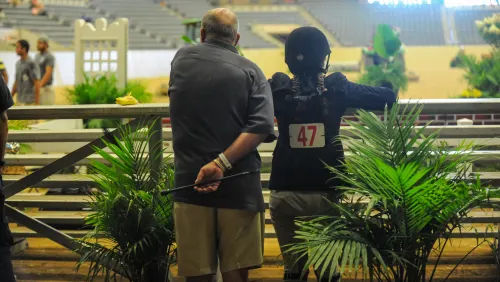I look around at the teachers and young professionals of tomorrow and I wonder if we as a sport have kept up with the need to educate our students and our teachers. Have we exposed them to all types of riding, teachers and horses?
And do we allow or encourage our veterinarians, blacksmiths and horse dentists to become involved with our teaching?
One major improvement we have made in the teaching department is with our judges. The live clinics that are now being presented for licensed judges are a definite improvement over the old classroom situation.
As I said in a previous column (Aug. 22, p. 21), the participants in the live judges’ clinics are just as important as the panelists. There is discussion about and comparison of what we see in each particular round and each individual class that’s being judged.
But I have to wonder why we don’t have similar clinics for the parents, riders and trainers who don’t have any intention of becoming judges but who need to know what judges are looking for in the classes they watch? I would suggest that the U.S. Equestrian Federation’s leaders need to open these clinics up to spread the education around.
Perhaps this would create a better understanding of the way classes are pinned. Maybe we could even decrease the unhappiness at the in-gates. Of course, I’m sure it will never go away!
I’ve never understood why our federation’s January conventions aren’t full of forums and demonstrations by our top blacksmiths, veterinarians, horse dentists and other professionals. Without the care of these people, we’re not doing our job to take care of our wonderful equine friends.
Our students and owners mainly see only the bills and don’t understand how important these people are. Bad teeth in ponies and horses create problems that lead to worse problems, eventually to a problem that can be extremely difficult (and even more expensive) to fix.
ADVERTISEMENT
Shoeing a horse correctly is also essential. Knowing when to pull their shoes and how long to leave them off is an art that’s passing us by. And, just as with teeth, poor care of our horses’ feet leads to problems that, if left unattended, can be irreversible.
Are we starting our beginner students safely and with the correct basics? Do we have enough riding programs to give first-time riders all around the country places to start and, better still, to continue to ride?
Just as importantly, are the good old horses still around to teach our students the love of riding?
I’m very fortunate to have a donation program here that allows horses who’ve left the show ring to serve a useful purpose. It is amazing to watch these horses take a deep breath and step into a more relaxed teaching mode. They know the ropes and put up with all the mistakes. I think the good ones end up teaching the instructors!
We need to provide more teaching clinics throughout the country. We have top riders and teachers, and we’re not asking them enough to pass their knowledge on to the next generation. We have already allowed top riders and trainers like Michael Matz and Rodney Jenkins to step to a different discipline (flat racing for both of them) before we were able to learn more from their expertise.
If we had open course designer clinics, it would be a truly valuable educational process for all the course designers who are not at the grand prix level. They set most of the courses throughout the year, from short stirrup to regular working hunter classes to three-foot medal classes to our top equitation classes.
It would be great if we had forums and clinics to teach course designing at all levels. If the top professionals would participate and exchange their ideas and principles with people who are interested in their art, we’d be far ahead of the game.
I really believe that educational forums like this would address some of the course problems we encounter today. For instance, I frequently see courses that require the horses to jump off just one lead for 90 percent of the trip.
ADVERTISEMENT
Course designers also have to be sure of the questions they’re asking when they set a course.
As shows become busier, we’re seeing courses that are set with the goal of getting as many horses through the ring in as little time as possible, instead of teaching or testing the horses and riders.
Breakaway cups are great, and I think our shows should use them at every level, at least at the back of oxers.
But hunter or equitation and jumper courses shouldn’t always use the same type of cups because we’re not asking the same questions, either in the ring or in the schooling area. Let’s make sure the hunter and equitation rings use the deeper safety cups, not the flat safety cups the jumpers use.
And we need to educate our customers as to why these safety cups are important and where they can buy them.
Our sport is growing each year, but our education of the participants is falling behind.
So we all need to brainstorm ideas of how to better train and educate all of us’trainers, owners, course designers and riders, from the lowest to the highest level. We need leaders who are not self-centered but who have vision and can implement it.














